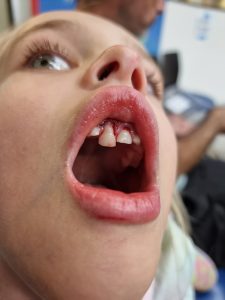Introduction:
As parents, we strive to protect our children from harm, but accidents can happen, and sometimes those accidents involve dental injuries. One such scenario is when a child’s tooth gets dislodged or pushed outwards due to a fall, a sports injury, or any other mishap. It can be a frightening experience for both the child and the parent, but knowing what steps to take can make all the difference in ensuring the best possible outcome for your child’s dental health.

Here’s what you should do if your child’s tooth gets dislodged or pushed outwards:
- Stay Calm: Your child will likely be upset and in pain, so it’s important for you to remain calm and composed. Your demeanor will greatly influence how your child reacts to the situation.
- Assess the Injury: Carefully examine your child’s mouth to assess the extent of the injury. If the tooth is completely knocked out, try to determine if it’s a baby tooth or a permanent tooth. If it’s a permanent tooth, it’s crucial to handle it with care to maximize the chances of successful re-implantation.
- Handle the Tooth Properly: If the tooth is intact, hold it by the crown (the top part that is normally visible in the mouth) and avoid touching the root. Rinse it gently with milk or saline solution to remove any dirt or debris. Do not scrub or clean the tooth with soap, disinfectants, or water, as this can damage the delicate cells on the root surface that are essential for successful re-implantation.
- Reinsert the Tooth (if possible): If the tooth has been pushed out of its socket but is still intact, try to reinsert it into the socket gently. Have your child bite down on a clean piece of cloth to hold the tooth in place until you can get to a dentist.
- Keep the Tooth Moist: If you’re unable to reinsert the tooth into the socket, store it properly to keep it moist. The best way to do this is by placing it in a container of milk or saline solution. Avoid using water or wrapping the tooth in a dry tissue, as this can cause the root cells to dry out and reduce the chances of successful re-implantation.
- Seek Immediate Dental Care: Regardless of whether it’s a baby tooth or a permanent tooth, it’s essential to seek dental care as soon as possible after a tooth injury. Contact John Street Dental or visit an emergency dental clinic for prompt evaluation and treatment. Time is of the essence, especially when dealing with permanent teeth, as the chances of successful re-implantation decrease rapidly after the first hour of injury.
- Manage Pain and Swelling: In the meantime, you can help alleviate your child’s pain and reduce swelling by applying a cold compress to the affected area for 10-15 minutes at a time. Over-the-counter pain relievers can also be given according to the recommended dosage for your child’s age and weight.
- Follow Up with Dental Care: After the initial treatment, follow any instructions provided by the dentist for ongoing care and monitoring of the injured tooth. Your child may need additional follow-up appointments to assess the healing process and ensure that no complications arise.
- Prevent Future Injuries: While accidents can’t always be prevented, taking precautions can help reduce the risk of dental injuries in the future. Encourage your child to wear a mouthguard during sports activities, avoid chewing on hard objects, and practice good oral hygiene habits to maintain strong and healthy teeth.
Conclusion:
In conclusion, knowing how to respond promptly and appropriately when your child’s tooth gets dislodged or pushed outwards can make a significant difference in preserving their dental health and minimizing long-term consequences. Stay calm, handle the tooth with care, seek immediate dental attention, and follow the guidance of your child’s dentist for the best possible outcome. Your quick actions and supportive care can help ensure that your child’s smile remains bright and healthy for years to come.






